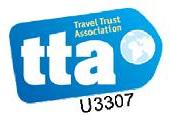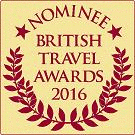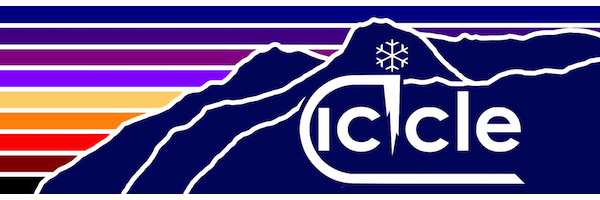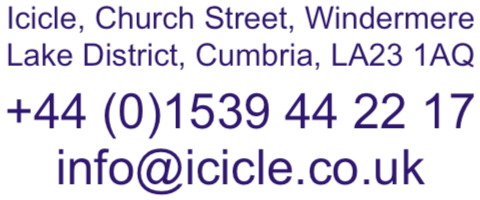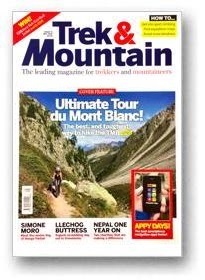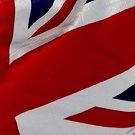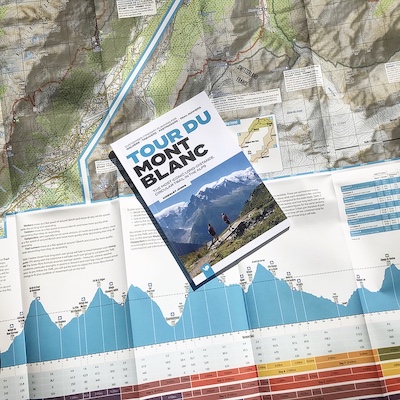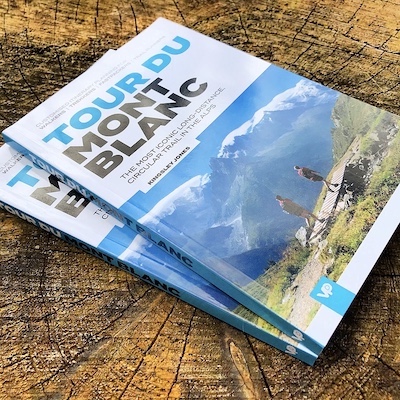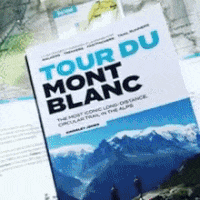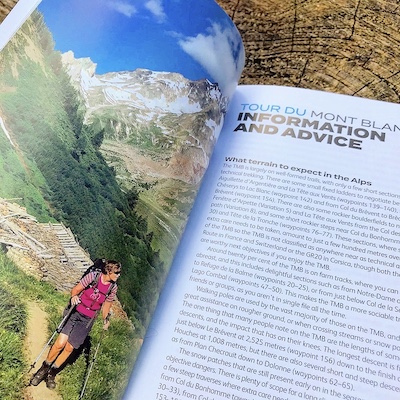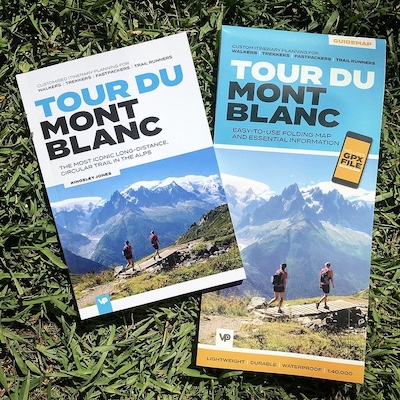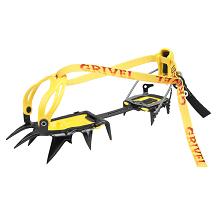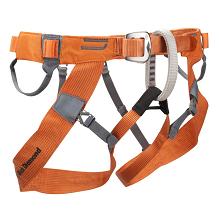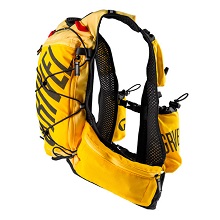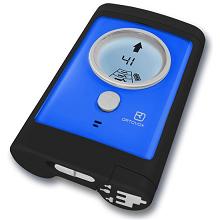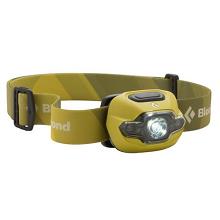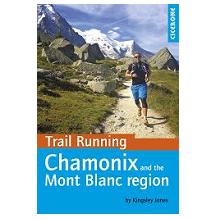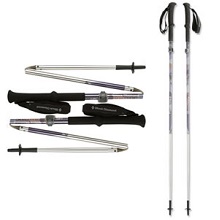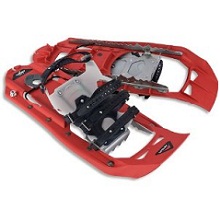 |
Alpine
treks - frequently asked questions

To view the full list of all our trekking courses around
the world, please visit the overview page by clicking
here. This page answers some of the
most common questions that we are asked by clients about
trekking in the Alps... |
 |
 |
 |
 |
 |
 |
 |
Are
trekking poles required?

|
|

For
all our guided treks, we classify trekking
poles as obligatory equipment, and will
not let anyone start without them. For
self-guided it is your choice. The reason
for our position on poles, is that they
are essential safety kit to help you
off a mountain if for example you twist
an ankle or knee. Even if you are fine,
when you learn to use poles efficiently
they take up to 30% of the load off
your knees on ascents, and make it a
lot easier ascending hills. With stats
like this, why wouldn't you use them?
 |
|
|
 |
 |

Can
I use a hydration tube pack?

|
|

Hydration
systems are good for enabling you to
sip fluids whilst trekking, which is
great. On the downside, they are highly
prone to leaking, and generally the
users are unaware how much they have
drunk, so struggle to monitor their
intake, an are likely to run out unexpectedly.
When the weather is very cold (unlikely
on sumer treks), the tubes and valves
can freeze. Whatever your decision,
it is worth taking a small bottle as
a backup in case you
have issues with the bladder system
(e.g. platypus).
 |
|
|
 |
 |

Can
I charge my phone / camera?

|
|

Never
assume that you can recharge a phone
or camera in any of the huts. Most are
sporadically powered by generator, and
the lights run off the hut batteries
on a low voltage system. In valley hotels
/ gites there are power sockets, so
look at any itinerary carefully to judge
where / if it is worth taking a charger.
 |
|
|
 |
 |

Do
huts cater for vegetarians?

|
|

Yes
they do, as long as they are warned
in advance. We require this information
at the time of booking, to be listed
on the online form. When you arrive
at a hut, it's worth reminding the hut
guardian that you are vegetarian, so
they know who you are. Other dietary
requirements may be possible, but often
the vegetarian dish is offered. Do note
that huts ate not restaurants, and they
don't cater for preferences a la carte.
 |
|
|
 |
 |

What
are the evening meals like?

|
|

Generally
hut evening meals are great, and at
least three courses. Often they start
with a soup, then the main is a good
balanced meal such as a stew with vegetables
or pasta with meatballs, then there
is a dessert. You can buy soft or alcoholic
drinks to have with your meal. The drinks
are not included in any of the package
prices.
 |
|
|
 |
 |

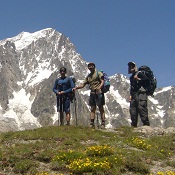 |
 |
 Photo gallery
Photo gallery

Tour
du Mont Blanc in Italy with the south face
of the Grandes Jorasses behind

 course
link
course
link |

What
plans are there for lunches?

|
|

We
do not provide any lunches on our courses,
as peoples preferences vary so much.
Some nibble on a chocolate bar, while
others eat several sandwiches or cereal
bars. Our recommendation is to take
what you normally enjoy eating on a
hill day. The huts all offer a packed
lunch for approximately 10€ a day,
and they mainly stock chocolate etc
to buy. On many treks you pass other
huts / cafes / gites / restaurants,
and if you opt to stop there for a meal,
that is fine too.
 |
|
|
 |
 |

Where
can I get drinking water?

|
|

When
trekking each day it will vary where
and how often you can get water. Most
people do not need to carry any more
than 1 or 1.5 litres of water to get
them between sources. These vary from
water troughs, to taps, huts, and villages.
If you are guided, your leader will
be able to advise when the next water
supply is so you can ration.
 |
|
|
 |
 |

Do
the huts take credit cards?

|
|

Occasionally
they do, but cash is king in the Alps.
Many huts do not have internet access
for card sales, so take enough money
with you. Most valley bases accept card.
It is highly recommended that you take
a card as several villages you pass
through have ATM machines where you
can withdraw cash.
 |
|
|
 |
 |

Where
do I go to the toilet?

|
|

All
mountain huts and accommodation have
toilets, so use the facilities before
you set off each day. Likewise any hut
facilities that you pass each day can
also be used. On busy routes there are
a few extra toilet facilities. If you
are out in the wilderness and need a
call of nature, if guided then ask your
leader where to go. They will assess
where is best for your privacy and to
safeguard water sources. Carry some
toilet paper and a small bag to carry
any tissue to the next rubbish bin.
 |
|
|
 |
 |

Can
I leave items I don't require?

|
|

If
you are starting a trek from our Alpine
base in Chamonix, then any items that
you don't require on your trek (e.g.
suitcase, travel clothes etc) can be
left at the base. We are the only UK
trekking operator with a full time base
in Chamonix, so this facility is a great
advantage. It is really essential that
you
travel as light as possible, so this
facility helps.
 |
|
|
 |
 |

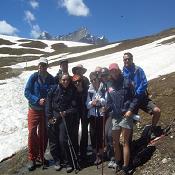 |
 |
 Photo gallery
Photo gallery

Passing
over Grand Col Ferret on the TMB, and starting
the descent into Switzerland

 course
link
course
link |

What
boots are most suitable?

|
|

This
is probably our most commonly asked
question, so we have produced a specific
page to answer these queries. The link
is Key
Alpine Kit.
The simple answer to the question above
is as follows. On every trekking course
we operate, including snowshoeing, you
will require well worn in trekking boots
that are waterproof and which offer
good ankle support. Retailers will usually
rate this style of boots as B2. If you
are unsure, ask at your local store.
If you are in any doubt as to the suitability
of your boots, we advise you to take
them on the course, and the staff will
check your equipment. If they consider
the boots unsuitable, they will advise
you to hire some boots for approximately
£5 per day.
 |
|
|
 |
 |

Do
I require gaiters & head torch?

|
|

The
weather can change rapidly in mountains,
and so we recommend that you take gaiters
on all Alpine treks. What was a sunny
day can easily be followed by a snow
storm on a high pass, so gaiters are
essential. For the same reasons, all
trekkers should always carry a head
torch, in case they are delayed by bad
weather, and for emergency use, as well
as practicalities such as finding the
hut toilet in the night. For all winter
snowshoeing treks, high gaiters (i.e.
up to just below the knee) are required
every single day to keep your legs and
boots dry.
 |
|
|
 |
 |

Which
items do I not need at all?

|
|

Over
the years we have seen some unique items
packed in peoples bags, despite the
fact that we supply highly detailed
specific kit lists. Please pack only
what is on the list that is sent you
when booking. Here are some of the most
interesting useless items we have found
people carrying to date in the Alps;
a dress (for hut dinners), a UK road
atlas (to stiffen the back section of
the rucksack), fluffy ear muffs (they
didn't like hats but got cold ears),
and alarm clocks (use your phone alarm).
 |
|
|
 |
 |

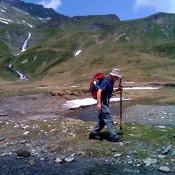 |
 |
 Photo gallery
Photo gallery

Trekking
in the quiet wilderness of the Fiz region
of the Aiguilles Rouges in Chamonix

 course
link
course
link |

What
type of insurance is needed?

|
|

Our
Booking Conditions require all clients
booking on a course to arrange activities
insurance as soon as their booking has
been confirmed (by e-mail or in writing).
You must check that your policy includes
cover for the following: medical expenses,
mountain search & rescue, personal
accident, money & documents, any
travel delay, personal liability, legal
expenses & cancellation, as well
as other circumstances for which you
require cover. We recommend that you
use BMC Alpine & Ski insurance:
www.thebmc.co.uk or 0870 010
48 78. It is highly unlikely that
any non-specialist trekking insurance
will provide this level of cover. Upon
arrival on a course, you will be asked
for documentary proof of your activities
insurance. Full details of the cover
provided by the BMC and Snowcard insurance
policies are on the insurance
page (click to link).
 |
|
|
 |
 |

What
is the etiquette for tipping?

|
|

When
you are staying in mountain huts, they
do not expect to receive tips. Hut guardians
make a lot of their income from selling
extras, such as wine with dinner, or
chocolate bars etc, so they always appreciate
you purchasing extra items such as these.
If you are trekking in a guided group,
it is always a nice gesture to tip your
guide if you have a good time. It's
up to you how you choose to do this.
Some opt to buy their guide lunches
each day, others get them a nice bottle
of wine at the end of the trek. Financial
tips are not required, but if you prefer
this, a tip of about 10€ per head
for a group of 6 would be generous,
and of course appreciated.
 |
|
|
 |
 |

Do
the huts supply towels?

|
|

The
huts do not supply towels, but they
are provided on the nights at each end
of the trek in the valley accommodation.
We recommend you take a small lightweight
travel towel for use in huts. Even
this is a optional luxury. If you wish
to travel extra light, you can simply
use a spare base layer to dry yourself
on.
 |
|
|
 |
 |
|
|
Do
I need a sleeping bag & pillow?

|
|

No
you don't. In huts they supply a bed
with a pillow and duvet / blankets.
You do not need to carry any bedding
at all, apart from a sleeping bag liner
for hygiene and confort. Huts insist
that you use the liner, and they can
be bought when you arrive in the Alps,
or you can pay to hire them each night
when in huts, though obviously this
is far more expensive.
 |
|
|
 |
 |

What
about a hot flask or stove?

|
|

In
the summer we recommend neither, but
if you prefer a hot drink, then parhaps
consider taking a small hot drinks flask
(c. 0.5 litres). You can buy hot drinks
in huts to put in it. A flask may well
be nice if you are on a winter trek,
but generally we advise against them
in summer. Carrying a stove is never
necessary, as there are so many places
in the mountains that you can buy a
hot drink, so weighing your bag down
is totally unecessary.
 |
|
|
 |
 |

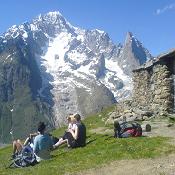 |
 |
 Photo gallery
Photo gallery

Stopping
for lunch on the Tour du Mont Blanc with the
Peutery ridge in the background

 course
link
course
link |

How
much cash do I need to take?

|
|

This
will vary from trek to trek, but on
all our treks you are briefed well before
you depart, so can arrange this in resort.
If huts are included, most people find
that approximately 20€ a day spending
money is quite sufficient. Most treks
pass a ATM cash machine at some point,
so you can get more cash out if required.
 |
|
|
 |
 |

What
currencies are required?

|
|

Check
what country you will be trekking in,
and take some local currency to get
you going. In most Alpine countries
the huts accept all the local currencies
(Euros in France & Italy, Swiss
Francs in Switzerland). However in Swiss
huts they also accept euros too, though
at a slightly less preferential exchange
rate.
 |
|
|
 |
 |

Are
baggage transfers included?

|
|

We
do not include baggage transfers in
any of our trekking courses. The main
reasons for this is that the mountain
accommodation is well away from roads,
so cannot be accessed by a baggage transfer
minibus. We see that as a selling point!
Obviously there is an ecological point
here too, as the baggage transfers are
completely unecessary - what do you
need a bag transfer for? You don't need
to dress up for dinner, are carrying
a small day sack anyway, and can wash
underwear / socks / base layers in the
huts anyway.
 |
|
|
 |
 |

What
do baggage transfers cost?

|
|

On
most of the routes that we offer as
treks in the Alps, baggage transfers
are not possible. If you want to pay
for a bag transfer on the days that
it is possible, it can be arranged,
and costs from 50€ per person per
week if all the participants require
the service. Contact us for details.
Some operators include baggage transfers,
but obviously you are staying in the
shady valleys next to a road, not in
the stunning wilderness of the mountains...
 |
|
|
 |
 |

How
long are the days trekking?

|
|

This
is the million dollar question. How
quick do you walk? For example the Tour
du Mont Blanc takes people between 7
and 14 days of trekking (already a factor
of 2). The record for the TMB is just
over 20 hours! We design our itineraries
around a nice steady trekking and ascent
rate, so each day averages around 5
to 8 hours trekking and about 900m of
ascent. The days are not designed to
be particularly challenging, but your
trekking endurance fitness does need
to be good so that you enjoy it.
 |
|
|
 |
 |

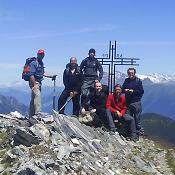 |
 |
 Photo gallery
Photo gallery

Trekking
group on the summit of Croix de Fer with the
Rhone valley and Martigny below

 course
link
course
link |

What
temperature are the huts?

|
|

The
huts are all designed to be comfortable
and suitably heated. For example most
people have the meals wearing t-shirts
rather than needing extra warm clothing.
However the temperatures drop if you
go outside in the evening or early morning,
for example to take photos, so we recommend
you take a warm insulation jacket. During
the nights the bedding is more than
sufficient to keep warm, and if you
get too hot, you can always open a window.
Don't worry at all about being cold
in huts!
 |
|
|
 |
 |

What
is the temperature range?

|
|

In
the summer the valley temperatures can
get as high as +35C, and the high passes
in bad weather can drop to just below
freezing, so you need to pack for a
wide temperature range. On good weather
days you will be most comfortable in
shorts and a t-shirt, and if you have
any mountain weather you'll need to
wear trousers, insulation jacket (e.g.
fleece) and full waterproofs. You need
to plan for everything so as not to
be caught out.
 |
|
|
 |
 |

How
do you stay clean / wash?

|
|

Most
mountain huts on popular trekking routes
such as the Tour Mont Blanc and Haute
Route have showers, so you can take
a travel towel and soap to wash each
day. On some more remote treks such
as the GR20 you should take wet wipes
to cater for huts without any showers.
You can also wash clothes in huts and
hang them out to dry on the terrace.
This means you can travel light and
avoid any baggage transfers. Keeping
clean isn't a problem on Alpine treks.
 |
|
|
 |
 |

Can
I shorten any of the days?

|
|

On
some treks if you are tired and want
to opt out of a section, it may be possible.
For example on some valley sections
of the TMB you could catch a bus. Obviously
this is not included for you (or your
guide) if you opt for it at any stage
during the trek. We should stress that
most groups do not require this ever.
 |
|
|
 |
 |

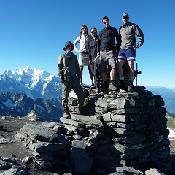 |
 |
 Photo gallery
Photo gallery

On
the summit of Mont Buet with Mont Blanc behind
on a Chamonix trekking week

 course
link
course
link |

My
pack is too large. Will it be OK?

|
|

We
suggest a c.35 litre pack as the largest
that is required for Alpine treks. Many
people tell us that they have a far
larger pack, and ask if it will be OK.
Yes it will obviously work, but you
need good side compression straps to
stop the contents slopping around, and
rubbing your back and shoulders. Also
you will be carrying up to two extra
kilos of bag for nothing. It's up to
you, but clearly a suitably sized bag
will be best.
 |
|
|
 |
 |

What
week for the best weather?

|
|

You
wouldn't believe how hard it is to predict
weather, and though we have been operating
courses well over a decade, there is
no clear pattern. In the Alps it is
slightly easier to predict the weather
patterns, than say in the UK, as there
is a stronger continental influence
on the weather systems. We can only
predict the weather for a particular
week in the Alps during as season, as
accurately as you can for you home on
the same week. During the course we
can provide you weather forecasts with
a high degree of accuracy. To view web
links to some of the better weather
sites that we use, you can visit this
link; weather
forecasts.
All we can provide is an outline of
the general tendancies that you can
often expect. For what they are worth,
some people attempt to provide very
generalised 6 month forecasts, adapting
the current weather for fairly predictable
climatic shifts, such as El Nino years
or the after effects of climatic disruptions
like the Eyjafjallajokull eruptions
in September 2010. The forecast of one
of the long range sites that is specific
to the Alps is at; TVmountain,
and if you don't speak any French you
can translate it through Google Translate.
In terms of the generalised weather
patterns, that we stress are highly
subject to change, the outline to potentially
expect is;

June - still fairly snowy in the high
mountains, with cooler nights, and the
longest days.

July - often some of the most stable
weather in the summer, though busy with
holidays.

August - a tendancy of warm sunny days,
and convection storms in the late afternoons.

September - as the days become shorter,
the weather often improves as it becomes
cooler.
 |
|
|
 |
 |

What
are the current conditions?

|
|

Unless
the weather is highly stable, we are
not able to predict conditions on any
trekking route until the day before
you set off. Sorry we cannot guess any
further ahead than this. On all our
trekking trips you are briefed on conditions
before you depart. To follow the
weather and see live webcams, click
here; weather
forecasts.
 |
|
|
 |
 |

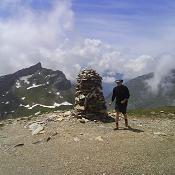 |
 |
 Photo gallery
Photo gallery

Crossing
the Col du Croix Bonhomme on the Tour du Mont
Blanc in the Beaufortain

 course
link
course
link |

What
about knife, fork, spoon etc?

|
|

No,
the huts supply all these items. Please
only take the items that you are sent
on your course specific kit list, that
is e-mailed to you at the time of booking.
If you take anything else, it is extra
weight, and unecessary.
 |
|
|
 |
 |
|
|
 |
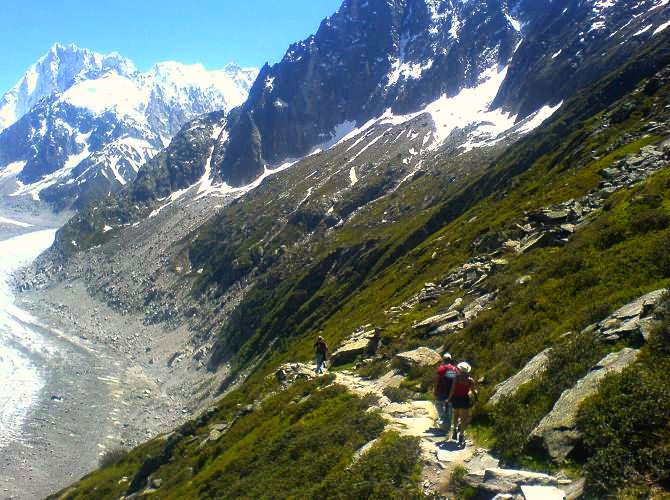 |
 |
What's
in your pack each day?

We suggest that for any of our Tour Mont Blanc guided
courses, you only take a day pack, to carry as little
as possible. The majority of clients manage with a small
rucksack of 25 - 30 litres capacity. Below is an outline
of the essential kit to carry each day. Don't forget that
all bedding is provided in huts, and you can leave extra
baggage in Chamonix whilst out on your trek. A detailed
kit list is sent to all those booking, but the list below
gives you an idea of how to pack a very lightweight bag
for a Tour Mont Blanc trek.
 |
|
|

Things that you DON'T need to take include; hut shoes
(provided), sleeping bag, roll matt, pillow, cutlery,
mugs, crockery, stoves & pots, evening wear for hut,
cards / games, maps, compass, guidebooks, alarm clocks,
ski goggles, balaclava, ear-muffs, scarf, etc. The art
of travelling lightweight is easy if using Alpine huts
as bedding and food is provided. Think of them as basic
mountain hotels, at which you can purchase soft and alcoholic
drinks, extra food and packed lunches for each day. Baggage
transfers are not required, as you are travelling with
a small pack that contains everything for personal use,
and most huts are inaccessible by road anyway! |
|
 |
|
|
 |
NEW Tour du Mont Blanc guidebook and map


A brand NEW guidebook for the Tour du Mont Blanc, and an accompanying waterproof map, has recently been launched by Vertebrate Publishing. It's unique and innovative, in several ways; timings for trip planning for all trail users from steady walkers to faster trail runners, 1:40,000 scale custom mapping provided on the description pages of the guidebook, and full appendices and kit lists to help you plan a trip and learn all about the route. The book is a nice size format of 175mm x 120mm, and it's detailed yet compact at 140 pages long, weighing only 300g. It's been designed by a TMB expert.
 |
|

That expert is none other than multi award-winning author, and veteran of over 50 laps of the TMB, Kingsley Jones from our guiding team. All of that experience of the route, timings, where to eat or stay, and customised itinerary planning, comes from him spending over a year of his life on the route. We are going to supply a FREE copy of the guidebook (RRP £16.95) and map (RRP £14.95) to each group on our self-guided TMB trips. If you'd like extra copies, or are on a guided trip, you can get them in advance of your trip for reading and planning. Order them from us; TMB guidebook and TMB waterproof map. |


 |
|
 |
|
 |
 |
Icicle logo
is the registered trademark ® of Icicle Mountaineering | | UK company 413 6635. VAT 770
137 933 UK company 413 6635. VAT 770
137 933 |
|
|
|
|

